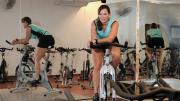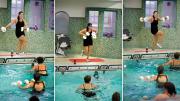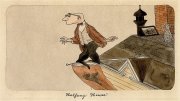In high school near Chicago and at Hope College in Holland, Michigan, Dawn Murdock Stenis played sweeper on the varsity soccer teams. Sweepers are the kingpins of a soccer defense: they play at the very back, behind everyone except the goalkeeper, and direct the side’s response to an attack. “Usually the goalie and the sweeper are the two bossy people on the field,” she explains. “But in college, our goalie wasn’t really comfortable being bossy, so I got to be super bossy. I have two younger siblings…and for as long as I’ve been in the work force, I’ve pretty much been the boss. It’s a good fit: stuff just works better when I’m in charge. I joke about it, but most people around me seem to agree.”
Indeed they do—in fact, by the thousands. Each week during the academic year, 10,000 men and women of Harvard wanting not only victory, but fitness, troop into the Malkin Athletic Center (MAC) and Hemenway Gymnasium to achieve their daily triumphs over the sedentary life. Once inside, they storm more than 100 cardio workout machines (treadmills, elliptical trainers, rowers, bikes, StairMasters, and the like), lift weights, and stretch, grunt, and sweat in about 100 group-exercise classes, ranging from aqua aerobics to Zumba, a dance fitness program (see https://recreation.gocrimson.com/recreation/group/index). As area fitness program manager, Murdock Stenis supervises the whole shebang.
“Movement works!” she says, with the conviction of a seasoned teacher, trainer, and all-around jock. She personally teaches 10 to 12 exercise classes weekly. Eight to 10 fitness staff and 50 or more class instructors report to her, along with 11 personal trainers.
In college, Murdock Stenis had a moment of epiphany. She had considered following her father into labor relations, and started as a business major. “Now mind you, I hate math and I’m terrible at it,” she confesses. “My freshman and sophomore years I studied like the dickens, and stuff just wouldn’t sink in because I totally didn’t care about it.” Then, at the start of her junior year, her grandfather died of cancer at 66—“way too young,” she says. “He was active in his work for GM for 30 years, but as soon as he retired, he just stopped moving. In my opinion, that killed him. That was my ‘holy cow!’ moment—grandchildren should not lose their grandparents that soon. I came back from the funeral and changed my major [to physical education] and decided that I was going to make the world move.”
Studying subjects like kinesiology, Murdock Stenis “couldn’t get enough,” she explains. “It came to me easily. I’d be reading things on the biomechanics of human movement or exercise physiology, and I’d be thinking. ‘I know what that is—that’s when my muscles burn,’ or ‘That’s like when I was injured and couldn’t extend my leg.’” Her grades went from straight Cs to straight As, and a career path opened up.
That path wasn’t new, exactly: Murdock Stenis grew up a tomboy (“the oldest child, a perfectionist, a Type A personality”) with two younger sisters (one, Janine, now teaches classes for her at Harvard). The family joke is that “Dawn is her father’s first son.” She had a Gale Sayers football in her toy box and as a four-year-old was entranced by Nadia Comaneci’s incomparable performances at the 1976 Montreal Olympics. In high school, she became a gymnast as well as a starting varsity soccer player. “If I’m not good at it, I’m not doin’ it!” she declares with a smile, “and I expect to be good right away.”
Shortly after graduating from college, she tore a medial collateral ligament in one knee in a skiing mishap. Six weeks in an ankle-to-hip brace ensued, another transforming experience. “That’s the one time in my life that I became sedentary,” she says. “And once that brace came off, I was tired, and got lazy. It’s inertia: bodies at rest stay at rest. I was stuck to the couch—I got ‘Velcro butt’—and gained 30 pounds in one year. But I lived across the street from a gym, and one of my girlfriends said, ‘You should try step aerobics, because you love to dance.’ She took me to my first step aerobics class, and I loved it.
“I also realized that I needed to have accountability for working out,” she continues. “I grew up having a coach and other athletes around me, pushing me. When it came time for me to do it all by myself, I wasn’t all that disciplined. That’s how I got into group fitness. There are a few people in this world who are self-motivated about exercise—they are usually called marathon runners, and everybody knows they are a little bit crazy. The rest of us need others to motivate us.
“Human beings are pack animals, social creatures, and we feed off the energy of the people around us. So hopefully, we’ll surround ourselves with high-energy people.” (She pays a staff member to train her because “I’m not going to push myself as hard as I need to be pushed.”) “So many people tell me, ‘Oh, I’m not a class person, I’m not into the group-exercise thing. But then you talk to them a little more and you find that they’re not doing nearly enough. Maybe it’s because they’re not doing the group thing, or they haven’t found the group thing they like. The classes come in so many forms.”
Part of Murdock Stenis’s preparation for her Harvard job came from five years as co-owner, with her former husband, of a 15,000-square-foot gym in Traverse City, Michigan. “It sounded great—I love teaching group exercise,” she says. “But when you own the business, you don’t get to do the parts of the business you love. There’s huge overhead, and way too much work.” (She often found herself plowing snow at 3:30 A.M. to be ready for the gym’s 5:30 A.M. opening.)
Eventually she divorced, sold the gym, and in 2003 came to work at Harvard. (She’s now married to John Stenis, a foreman in Harvard’s electrical distribution department.) Officially she works for Town Sports International, which operates fitness centers in Boston, New York, Philadelphia, and Washington and has a long-running contract with the University to provide staff and services at the MAC, Hemenway, and the Business School’s Shad Gymnasium. “The idea of Harvard being not-for-profit, and doing health and fitness to change lives, not for the almighty dollar, was incredibly attractive to me,” Murdock Stenis explains. “Here, we get to do what we do simply for the results. There’s so much freedom.”
Freedom to design new specialty programs like Harvard Slim Down, for example, now in its third year. (The eight-week fitness/weight-loss program offers a wide variety of group exercise classes plus personal training). She has introduced the pre- and postnatal “fit mamas” class, hip-hop and belly dance, yoga for pain or injury relief, and the “pedomination challenge,” in which small walking teams from across the University compete by logging their daily step totals on pedometers. “My job is to identify what the Harvard community needs, and see if we can give it to them,” says Murdock Stenis. Gym and exercise-class attendance is growing. Yet, as she points out, “You talk with people in the gym, but that only takes us so far, because my goal is to reach the people who aren’t coming in the door. Those are the ones who really need us.”










